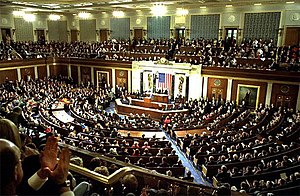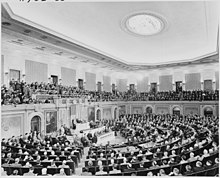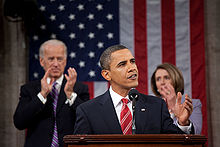State of the Union
![]()
SOTU is a redirect to this article. For other meanings, see SOTU (disambiguation).
For the speech of the same name in the EU, see State of the Union address.
The State of the Union Address (SOTU) is an annual event in which the President of the United States delivers a statement of his assessment of the state of his country to a joint session of both houses of Congress. He also uses the occasion to present his own pending legislative initiatives. Like the swearing-in ceremony, this speech usually takes place in January, although occasionally it does not take place until February. In years when a new president takes office, there is usually no State of the Union Address in the Congress building, but instead a swearing-in speech delivered outdoors in front of the building.
In its origins, it is modeled on the British monarch's Speech from the Throne and follows a prescriptive from the Constitution addressed to the President:
"He shall from time to time give to Congress information of the State of the Union and recommend to their Consideration such measures as he shall judge necessary and expedient."
"He shall from time to time report to Congress on the condition of the Union, and recommend for its consideration such measures as he may deem necessary and useful."
- Article 2, Section 3, Constitution of the United States
The Constitution does not prescribe what form the report should take, what its contents should be, or how frequently such a report should be made. Just as each president's style of government bore his or her own signature, so too did they individually use the freedoms that the constitutional provision left them to deliver this speech.

House Chamber in the Capitol during President George W. Bush's State of the Union Address, January 28, 2003.
History
The first State of the Union address was delivered on January 8, 1790, by the first president, George Washington, in the provisional capital of New York. It was still under the impression of the only recent founding of the state, with the Revolutionary General of the War of Independence appealing to unity among the former colonies in the disputes between Federalists and Democratic-Republicans.
Thomas Jefferson, who ruled the country from 1801 to 1809 and always resisted any pomp and any appeal to old monarchical forms, introduced the tradition, preserved until 1913, that the president no longer read his speech himself, but merely wrote it down and sent it to Congress, where it was then read by an official. The length, content, and rhetorical forms subsequently varied; while domestic politics and the problems surrounding slavery and secession initially dominated, America's foreign policy role increasingly came to the fore from the end of the 19th century.
Woodrow Wilson's return to the old format in 1913 of delivering the speech himself was maintained by all subsequent presidents. Up to and including 1934, the speech was delivered in December. With the passage of the 20th Amendment to the Constitution in January 1933, the legislative session of Congress was moved forward from March to January and the timing of the speech was moved to its beginning.
Today, the speech is usually held on the last Tuesday in January, although there is no binding rule for this date and in individual cases it is also deviated from. This case has only occurred twice in history: Ronald Reagan postponed his speech scheduled for January 28, 1986, by a week when the space shuttle Challenger exploded around noon of the same day. Donald Trump's 2019 speech was postponed by nearly a week due to disagreements over the budget dispute and the related longest government shutdown in United States history, as House Speaker Nancy Pelosi did not issue Trump an official invitation to hold a joint session of Congress.
In 1922, Warren G. Harding's speech was broadcast over the radio for a small audience; that of his successor, Calvin Coolidge, in 1923 was the first to reach a national audience. In 1947, Harry S. Truman's speech also began to be broadcast on television. Lyndon B. Johnson's speech in 1965 was the first to be broadcast on evening programming to reach a wider audience. With George W. Bush's address, the State of the Union address has also been livestreamed on the Internet since 2002.
meaningful speeches
- In his State of the Union address on December 2, 1823, President James Monroe formulated the Monroe Doctrine, which was significant for the future foreign policy of the United States.
- During World War II, President Franklin D. Roosevelt formulated the "four freedoms" on January 6, 1941.
- On January 23, 1980, President Jimmy Carter declared the Persian Gulf region a U.S. "sphere of influence."
- President Ronald Reagan introduced the public to the doctrine named after him in his February 6, 1985 speech.
- On January 29, 2002, in his first State of the Union address after the September 11 attacks, President George W. Bush listed North Korea, Iran, and Iraq as an "axis of evil."

House Chamber during the State of the Union Address by President Harry S. Truman, January 4, 1950.

State of the Union by President Kennedy, January 14, 1963.
Sequence of the speech
In the State of the Union Address, the President traditionally highlights the accomplishments of the past year and refers in optimistic tones to his plans for the coming year. In recent times, distinguished foreign statesmen or American citizens have often attended the event as lodge guests, to whom the president then refers in the speech.The President is not authorised to enter the meeting room without the authorisation of Congress. Formally, therefore, he must be invited to speak by Congress. The President, upon entering the chamber, is announced by the Master of Ceremonies of the House ("Sergeant at Arms of the United States House of Representatives") with the words, "Mr. Speaker, the President of the United States!" (Mr. Speaker, the President of the United States! ) announced. Greeted by a standing ovation, the President then strode to the podium and, before beginning the speech, handed a copy of each to the Speaker of the House of Representatives and to the Vice President in his capacity as President of the Senate. If either is unable to attend, he shall be represented at the session by the next senior member. They shall take their seats behind the President during the speech.
The justices of the Supreme Court, the members of the Cabinet and the Joint Chiefs of Staff attend the meeting, thus emphasizing the state-act character of the whole. However, in order to ensure continuity of governance in the event of a disaster, one Cabinet member remains absent from the speech as a so-called "designated survivor". Since the attacks of September 11, 2001, it has also been customary for at least some members of Congress to stay in an undisclosed location for the duration of the speech to be available in case the Capitol becomes the target of an attack.
When the raucous reception by those assembled has died down, the Speaker of the House of Representatives signals with a few bangs of his gavel that the speech ceremony proper is now about to begin. The President is introduced to the House by the Speaker, there is another short round of applause before the President then begins his speech.
The speech itself is now supported by the use of a teleprompter and lasts on average a little over an hour, with frequent pauses during which passages are commented on by applause from those present, sometimes by all those assembled, and in the case of more party-political issues mainly by the president's party.

President Obama during his State of the Union address on January 27, 2010 (audio ogg format) - Vice President Joe Biden (in his role as Senate President) and Nancy Pelosi, Speaker of the House of Representatives, in the background.
Search within the encyclopedia